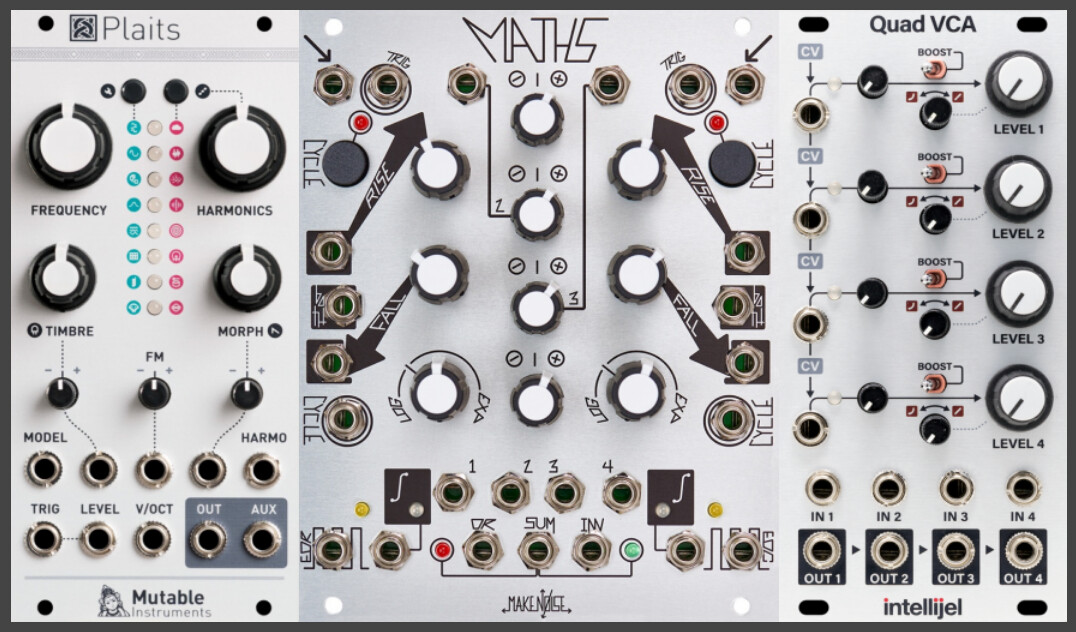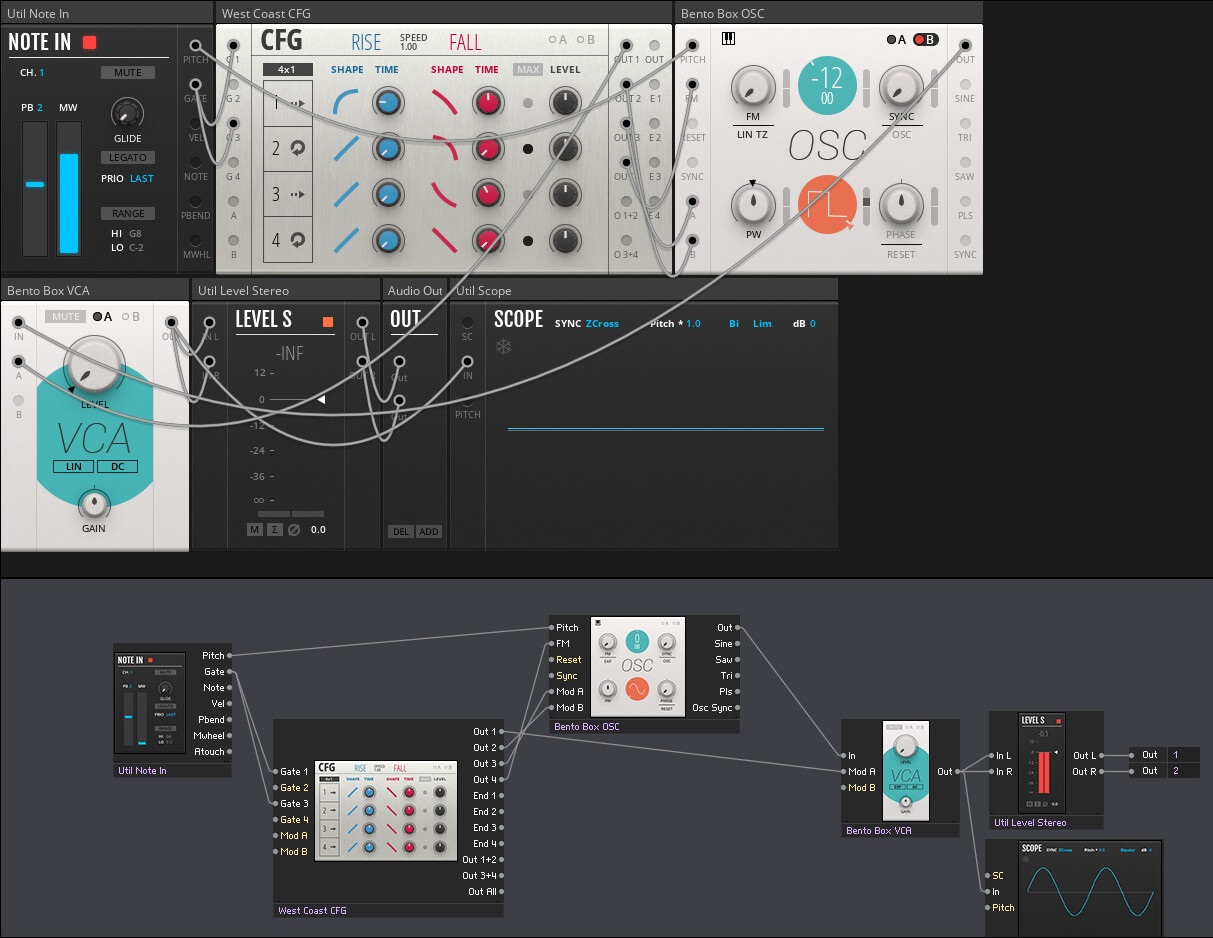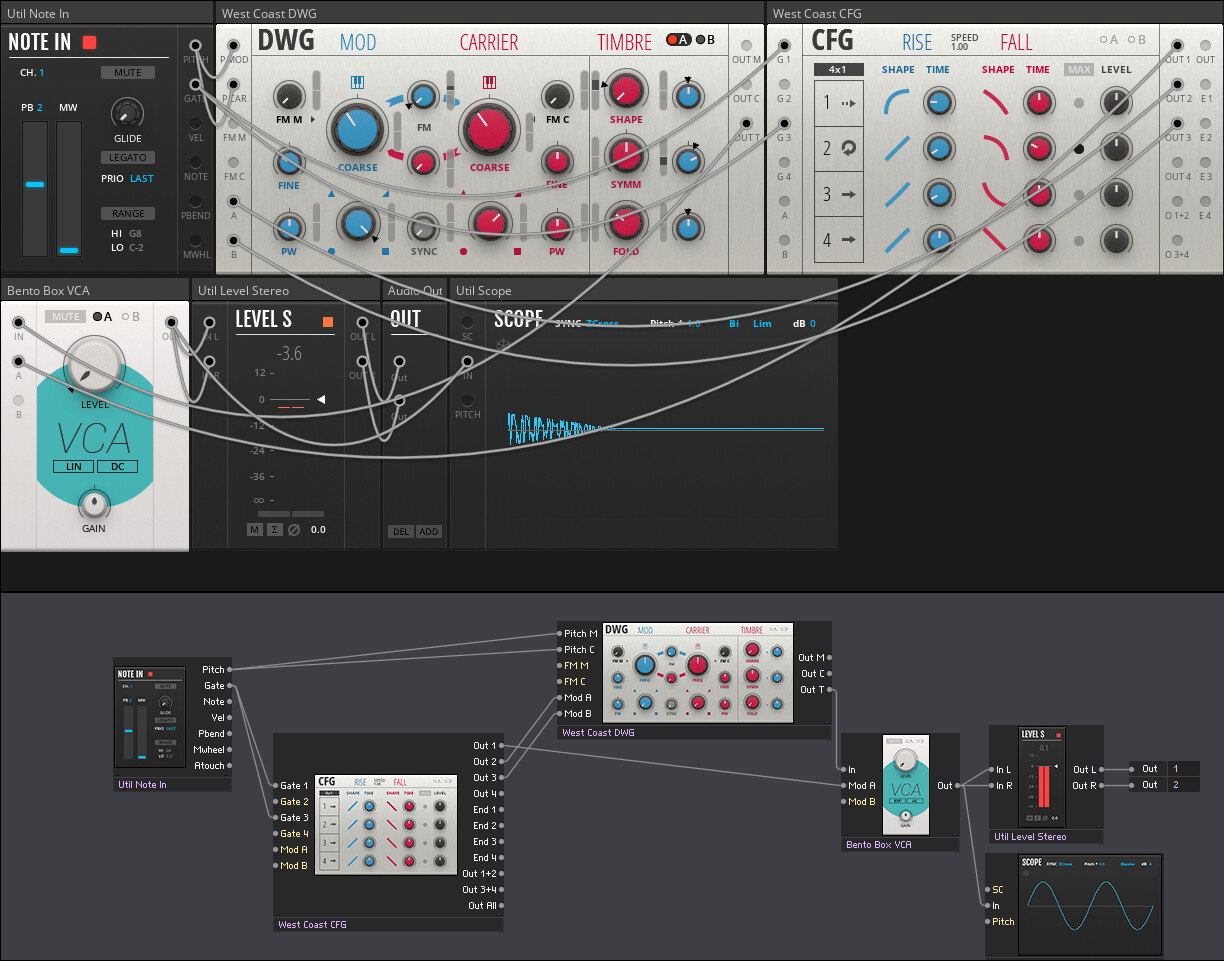First Three Eurorack Modules and Reaktor
What are the first modules to get, when starting with Eurorack? I am trying to answer that question for myself and look into digital alternatives in Reaktor.
What Modules are Necessary?
The day I start with Eurorack hardware, I want to be able to make things go bleep. So, I need the tools to hook everything into my existing hardware and I need enough modules to make the first sounds. From there, I think, it is useful to slowly grow the collection since every module can take on different roles. If you take your time with each new purchase, it is much more likely that you learn the ins and outs of your instrument.
First, a VCO (Voltage Controlled Oscillator) is necessary to actually produce the bleep. But a continuous sound on its own is not the most interesting thing, so I would like to either have a sequencer that produces CV (Control Voltage) signals to change the notes of the oscillator, or go with a MIDI-to-CV interface makes the VCO playable with any MIDI source. With a DC coupled interface module, which would be able to digitize and create CV signals, I could even integrate software systems like VCV Rack or Reaktor into the hardware modular rack.
Modular needs modulation, so the second module needs to be able to generate envelopes or be an LFO (Low Frequency Oscillator).
Third, you can never have enough VCAs (Voltage Controlled Amplifier). They modulate the level of any given signal by applying a CV – this has so many applications that you really can always make use of more VCAs. To listen to this minimal rack, I can just patch the output of the VCA into my mixer and interface.
Finally, I need miscellaneous goodies like a power supply, with +/- 12V, +5V and enough power for upgrades, as well as patch cables and a case.
What Would I Buy?
Eurorack is comparably expensive, so money is definitely a factor. On the other hand, it could make sense to put more money to get modules that offer more features – minimizing the first modular rack, if you will.
Here is a modular grid of what I would actually start with. Plaits by Mutable Instruments is a popular VCO that allows for lots of experimentation and exploration of synthesis techniques. Maths by Make Noise is probably the module to have in any rack and people recommend it because of its versatility. The many options are exactly why I would get this model with an initial order. For example, Maths can serve as an LFO and an envelop generator at the same time. The Quad VCA by Intellijel can be used to mix signals together or just use the individual channels. These three modules will provide plenty of ways to make things go bleep on day one.

Minimal modular Eurorack
As a sequencer, I would buy the Arturia Beatstep Pro. It appears to be a great sequencer that is also applicable in many non-modular setups. But I am also having second thoughts about getting a MIDI-2-CV or a DC coupled audio interface instead and use digital sequencers instead.
The price tag is already quite heavy. Modular grid estimates 737€, just for the three modules, excluding the sequencer and any necessities. So starting like this is not the cheapest step into the modular world and it gives you a better idea of how expensive these instruments really are.
Just to be not only complaining about the prices, I do understand the prices! Hardware design, production and quality control is a pricey business, especially in a niche. You want your tools to be reliable as well and that includes effects like stability of oscillators under different environmental conditions.
Build It In Reaktor
To get a hang of modular without buying anything right away, I started looking into software options. You might have seen a couple of experiments already in my previous post, but I was thrilled to find that VCV Rack and Reaktor have many digital equivalents to popular Eurorack modules. So lets see how Plaits, Maths and the Quad VCA could be realized in software.
With four simple VCAs, the West Coast CFG and a VCO I have a very similar setup as described above. The West Coast CFG is also a function generator, like maths, and will allow you to explore the concepts behind its design. A simple VCO is not necessarily comparable to Plaits, so I also gave the West Coast DWG a chance. It is a FM oscillator pair with a carrier and a modulation channel.
Basic Patches
Let us build some simple patches with these three modules:

Three block modular
Modulating the amount of FM, for example, results in a repeating wupwupwup (official term):
Having a square-wave, you could also get your wupwup by putting the LFO on the pulse width instead:
Using the envelope on the pulse with instead, gives us a weirdly evolving sound:
Finally, what happens if you apply your LFO modulation in an audible range?
Reaktor processes modulation signals up to a certain limit frequency.
It is 400 Hz by default, but can go up to 3.2 GHz.
An audible frequency oscillation modulation of the pulse width, combined with an envelope on the wave shape (from square to sawtooth), sounds like this:

Three block modular with the West Coast DWG VCO
With a more complex VCO, like the West Coast DWG, you immediately get more fun angles of modulation.
The DWG is a combination of two VCOs that are hooked into a classical FM synthesis with one frequency modulating the other.
I have made a nice raw bass sound with similar modulation strategies:
Final Thoughts
Now this is really just a first impression on both, what the hardware modules could do and how an instrument could come to life by combining these three modules. I have not touched the QuadVCA at all and Plaits would provide much more types of sounds than the two VCOs shown here. But it already is fun to build the instrument – modular is the Lego of music instruments!